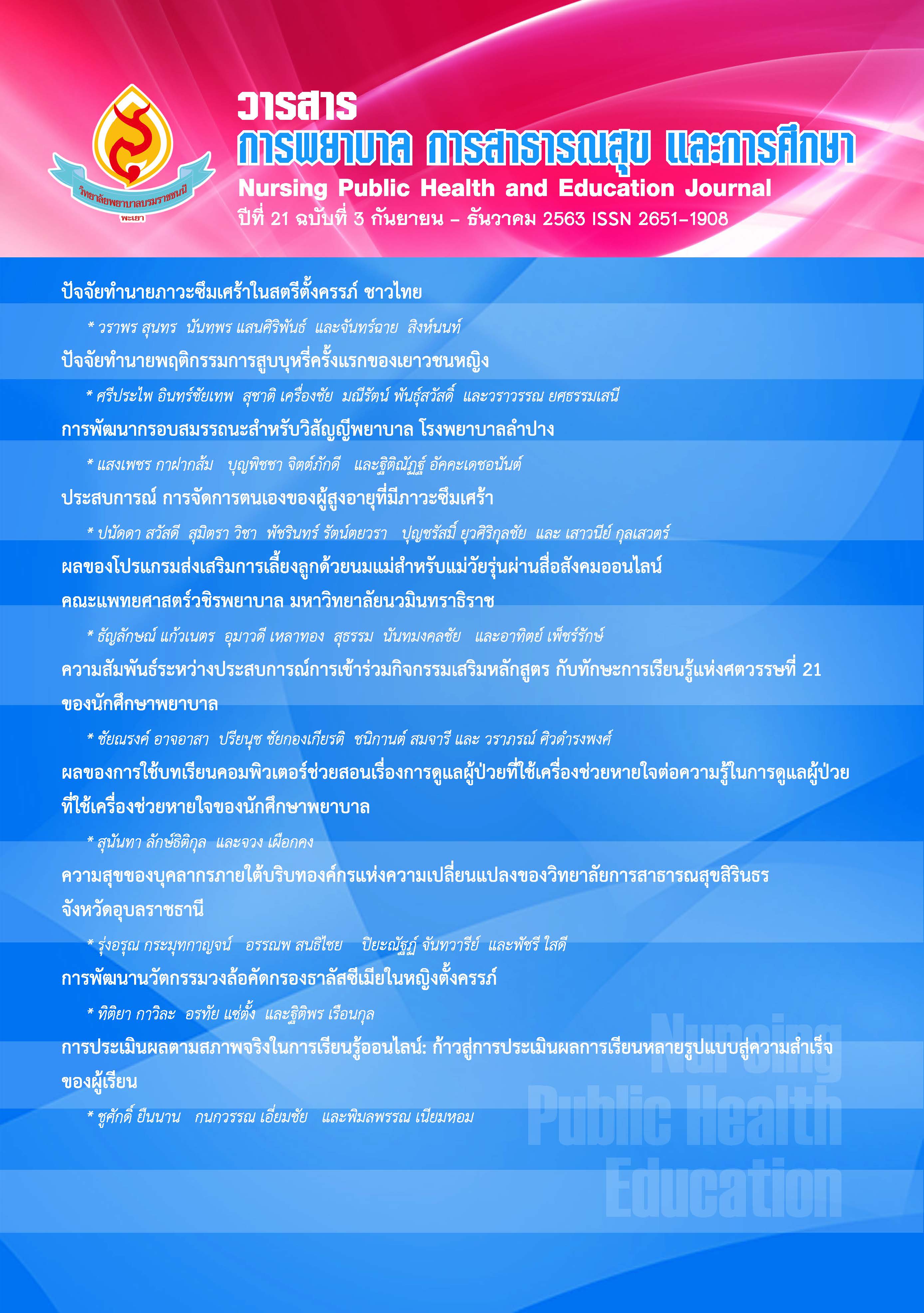การประเมินผลตามสภาพจริงในการเรียนรู้ออนไลน์: ก้าวสู่การประเมินผลการเรียนหลายรูปแบบสู่ความสำเร็จของผู้เรียน
คำสำคัญ:
การเรียนพยาบาลออนไลน์, การประเมินผลตามสภาพจริง, การประเมินผลการเรียนบทคัดย่อ
บทความนี้มีวัตถุประสงค์เพื่อเผยแพร่แนวทางการจัดการเรียนการสอนออนไลน์และการประเมินผลการเรียนตามสภาพจริงทางการพยาบาล การประเมินตามความเป็นจริงและวิธีการเรียนการสอนออนไลน์เป็นรูปแบบการเรียนการสอนที่อำนวยความสะดวกและสนับสนุนนักเรียน อีกทั้งช่วยให้ครูสามารถจัดการกิจกรรมการเรียนรู้และส่งมอบเนื้อหาวิชา ผ่านระบบเทคโนโลยีสารสนเทศและระบบมัลติมีเดีย การช่วยให้ผู้เรียนประสบความสำเร็จในหลักสูตร มีวิธีการหลายวิธี รวมถึงการเปิดโอกาสให้ผู้มีส่วนได้ส่วนเสียมีส่วนร่วมอภิปราย และสร้างกิจกรรมการเรียนรู้ร่วมกัน ถึงแม้มีวิธีที่นิยมสามารถเพิ่มประสิทธิภาพการเรียนรู้ เช่น อีเมล แชทโซเชียลเน็ตเวิร์ก การประเมินการเรียนการสอนออนไลน์อย่างเหมาะสม ยังมีความจำเป็นต้องมีการจัดการที่ถูกต้องตามหลักการประเมินผลการเรียน เพื่อยกระดับความสามารถของผู้เรียนภายใต้หลักสูตรการพยาบาล ดังนั้นการประเมินผลการเรียนรู้ควรใช้วิธีการประเมินที่หลากหลายและการรวบรวมข้อมูลที่หลากหลายเพื่อสะท้อนพฤติกรรมที่คาดหวังในตัวผู้เรียน เครื่องมือการประเมินที่แท้จริง เช่น รูบริคส์ที่ใช้ในการตรวจสอบประสิทธิภาพของนักเรียนได้ตามสภาพจริง และสามารถเป็นแนวทางให้ผู้เรียนพัฒนาตัวเองได้ การประเมินโดยใช้รูบริคส์จะช่วยให้ผู้เรียนทราบจุดประสงค์การเรียนรู้ และเกณฑ์ผลการเรียนรู้ ที่นำไปสู่ผลสัมฤทธิ์ทางการเรียนของนักเรียน ดังนั้นการเรียนรู้ออนไลน์และการประเมินที่แท้จริงช่วยให้นักเรียนมีโอกาสมากขึ้นในการใช้ความรู้ ประสบการณ์ และความสนใจในการสร้างสรรค์งานและเรียนรู้โดยตั้งเป้าหมายติดตามความสำเร็จด้วยตนเอง
เอกสารอ้างอิง
จินตวีร์พร แป้นแก้ว, บุษยา สังขชาติ, นวพร ดำแสงสวัสดิ์, และเทิดศักดิ์ นำเจริญ (2562). การประเมินตามสภาพจริง. วารสารศึกษาศาสตร์. 30(1), 22-33.
แดนชัย ชอบจิตร, ดลนภา ไชยสมบัติ, และสุทธินี มหามิตร วงค์แสน. (2560). ผลของการจัดการเรียนรู้โดยใช้บทเรียนผ่านเว็บ (Web-Based Instruction) ในรายวิชาการพยาบาลครอบครัวและชุมชน 2 สำหรับ นักศึกษาพยาบาลศาสตร์ วิทยาลัยพยาบาลบรมราชชนนี พะเยา. วารสารการพยาบาล การสาธารณสุข และการศึกษา. 18(2), 95-105.
ชูศักดิ์ ยืนนาน. (2546). การพัฒนาแม่แบบเพื่อการจัดเก็บแฟ้มสะสมงานอิเล็กทรอนิกส์ในการประเมินผลการเรียนรู้. วิทยานิพนธ์ปริญญามหาบัณฑิต มหาวิทยาลัยเชียงใหม่.
ฐาปนีย์ ธรรมเมธา. (2557). อีเลิร์นนิง: จากทฤษฎีสู่การปฏิบัติ e-learning: from theory to practice. โครงการมหาวิทยาลัยไซเบอร์ไทย. นนทบุรี: บริษัท สหมิตรพริ้งติ้งแอนด์พับลิสชิ่ง จำกัด
นวรัตน์ ไวชมภู และสุจิตรา จรจิตร. (2559). ความท้าทายของครูพยาบาล: Teach Less, Learn More แห่งศตวรรษที่ 21. วารสารมหาวิทยาลัยนราธิวาสราชนครินทร์ สาขามนุษยศาสตร์และสังคมศาสตร์, 3(2), 73-81.
สำนักงานคณะกรรมการการประถมศึกษาแห่งชาติ กระทรวงศึกษาธิการ. (2557). การวัดและประเมินผลสภาพแท้จริงของนักเรียน. กรุงเทพฯ: โรงพิมพ์คุรุสภาลาดพร้าว.
Ashford-Rowe, K., Herrington, J., & Brown, C. (2014). Establishing the critical elements that determine authentic. Assessment & Evaluation in Higher Education, 39(2), 205-222.
Bukharaeu, N., & Altaher, A. W. (2017). Mobile learning education has become more accessible.American Journal of Computer Science and Information Technology, 5(2), 1-5.
Ertmer, P. A., & Newby, T. J. (2013). Behaviorism, cognitivism, constructivism: comparing critical features from an instructional design perspective. Performance Improvement Quarterly. 26(2),43-71.
Intharawiset, T., Phulketnakhon, T., Charoensa, T., Nakin, N., & ReaungRong, P. (2019).Technology and innovation for instructional in digital ages. Humanities, Social Sciences and Arts, 12(6), 478-494.
Kimsungnoen, N., & Petchtang, S. (2016). The effect of E-learning courseware media on the learning achievement of nursing students at the School of Nursing, Rangsit University. Thai Red Cross Nursing Journal, 9(1), 63-74.
Klaharn, R., & Chaiso, P. (2013). The development of a competency assessment system for nursing students’ practicum. Journal of The Royal Thai Army Nurses, 14(2), 48-58.
Kodtra, P., Poklin, S., & Krommeung, A. (2017). The future of educational administration of bachelor of nursing programs in the ASEAN economic community. Journal of Health Science Research, 11(2), 18-27.
Phuwipadawan, S. (2001). Learner centeredness and authentic assessment. (3rd ed.). Chiang Mai:The Knowledge Center.
Sanboonsong, P. (2017). Learning styles of undergraduate nursing students of Pathumthani University. Thai Red Cross Nursing Journal, 10(1), 154-164.
Saraketrin, A., Rongmuang, D., & Chantra, R. (2019). Nursing education in the 21st century: Competencies and roles of nursing instructors. Journal of The Royal Thai Army Nurses, 20, 12-20.
Sisiadngam, W., Kaenampornpan, P., & Vilailuck, S. (2019). Authentic assesment of the music instrument practice course in higher education. Journal of Educational Measurement, Mahasarakham University, 25(1), 16-27.
Suttarat, S., & Somkumlung, P. (2012). A study of the critical thinking abilities of nursing students at a Boromarajonani College of Nursing Nakhon Phanom. Nursing Journal of The Ministry of Public Health, 22(1), 61-67.
Thongjan, P. (2018). The development of electronic student portfolio displayed on smartphone by applying QR code. The Journal of Social Communication Innovation, 6(1), 188-197.
Villarroel, V., Bloxham, S., Bruna, D., Bruna, C., & Herrera-Seda, C. (2018). Authentic assessment: Creating a blueprint for course design. Assessment & Evaluation in Higher Education, 43(5), 840-854.
Visudtibhan, P. J., & Disorntatiwat, P. (2015). Learning style preferences of nursing students at Ramathibodi School of Nursing, Faculty of Medicine, Ramathibodi Hospital, Mahidol University. Nursing Journal of the Ministry of Public Health, 25(1), 70-82.
Wadyim, N., Wangchom, S., & Mano, A. (2017). Teaching and learning management in nursing using electronic leaning. Journal of Boromarajonani College of Nursing, Bangkok, 33(3), 146-157.
Wetcho, S. (2018). Investigate cloud-based E-portfolio, an explicit tool for learning transitions. Journal of Education Studies, 46(4), 102-123.
Wiggins, G., & McTighe, J. (2005). Understanding by design. (2nd ed.). Alexandria, VA: Association for Supervision and Curriculum Development ASCD.
Wishart, J. (2018). Ethical considerations in the incorporation of mobile and ubiquitous technologies into teaching and learning in educational contexts. Retrieved February 14, 2019, from https://www.researchgate.net/publication/321150203
ดาวน์โหลด
เผยแพร่แล้ว
รูปแบบการอ้างอิง
ฉบับ
ประเภทบทความ
สัญญาอนุญาต
ลิขสิทธิ์ (c) 2020 วารสารการพยาบาล การสาธารณสุข และการศึกษา

อนุญาตภายใต้เงื่อนไข Creative Commons Attribution-NonCommercial-NoDerivatives 4.0 International License.



